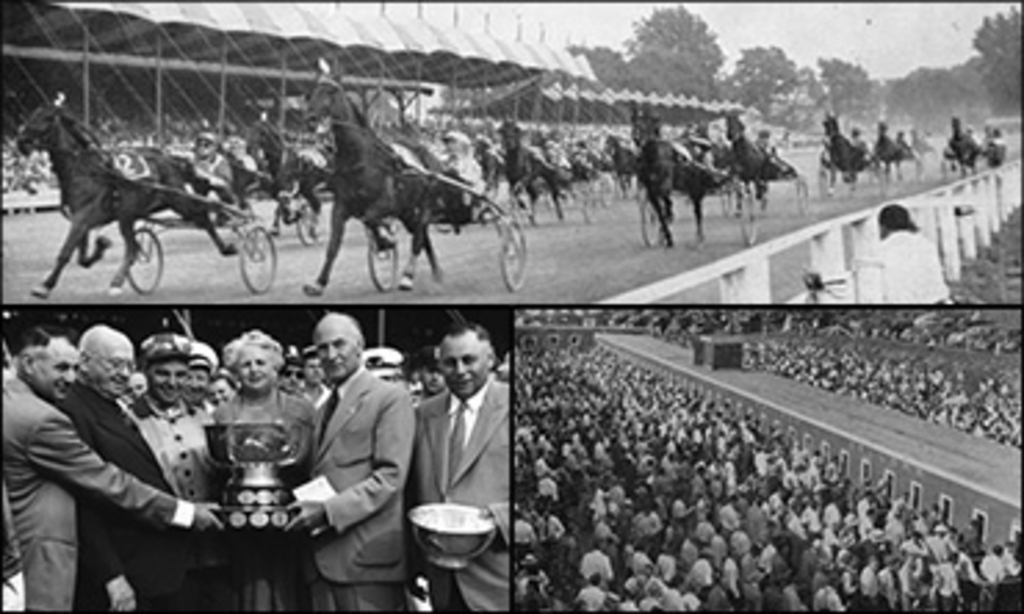
 In this week's edition of Rewind coinciding with Hambletonian weekend, Robert Smith recalls a great Hambo victory by a filly named Helicopter in 1953. This marked the first time in the race's then 27-year history that a Canadian owned entry had won the prestigious race.
In this week's edition of Rewind coinciding with Hambletonian weekend, Robert Smith recalls a great Hambo victory by a filly named Helicopter in 1953. This marked the first time in the race's then 27-year history that a Canadian owned entry had won the prestigious race.

Helicopter in rein to Harry Harvey leads a huge field of 20 on Hambletonian Day August 12, 1953 to secure victory in the third and final heat at Goshen, N.Y. (Hambletonian Society Photo)
Ninety years ago in 1926, the first ever Hambletonian was held at Syracuse, N.Y.. A Canadian driver named Nat Ray, originally from Toronto, was the winning driver behind Guy McKinney. Sixty years ago in 1946, the Hon. Earl Rowe of Newton Robinson, Ont. became the first Canadian to own, train and drive a horse in the big race. In keeping a deathbed promise to Van Riddell's breeder, Dr. Wm. Riddell to start the horse, Mr. Rowe made history on that day, despite not earning a cheque.
This year marks the 63rd anniversary of a rather memorable event in harness racing history which involved HELICOPTER winning the 1953 Hambletonian, then held at Goshen, New York. It marked the first ever Hambo victory by a Canadian-owned horse and it also was perhaps the first "giant step" by The Armstrong family of Brampton, Ontario who would go on to author many great harness racing moments in the years that followed. Two mares -- Helicopter, a trotter and Dotties Pick, a pacer -- were very early stars for this family and their influence continued throughout the decades.
This momentous victory by Helicopter occurred very early in the Armstrong's involvement in harness racing. The young filly sired by Hoot Mon, winner of the 1947 Hambo, had been originally purchased at auction as a weanling for $1,150 by Castleton Farm. She was again sold as a yearling for $2,000 to the partnership of John Simpson and Delvin Miller. She eventually made her way into the ownership of road builders J. Elgin and Edwin "Ted" Armstrong early in her two-year-old form for the sum of $7,500, remaining in the care of Delvin Miller as part of the deal. Originally named Belard Monia, her name was changed to Helicopter while in the ownership of Castleton Farm. The reason for the name selection was inspired by Mrs. Van Lennep, who along with her husband owned the Castleton establishment. Due to a severe storm, a helicopter was called in to transport Mrs. Van Lennup to the hospital to deliver a child. (I am glad they chose Helicopter)
Twenty-Three (23) Horses Go To The Post - August 12, 1953
The 1953 edition of the Hambletonian was literally 'one for the books'. It must have been truly a sight to see 23 trotters all start in the same race; especially three-year-old trotters! The race consisted of three heats, but they were not the elimination format. The horses lined up in three tiers 10-10-3. Scoring from post #14, Helicopter got off to a horrible start, finishing a distant 17th in the opener following an early break. Her connections were concerned, but one person who was still confident was trainer Delvin Miller. In the second heat, the same 23 horses again all started. This time Helicopter was flawless despite being saddled with such a poor post position (#17), trotting home a winner in 2:02 4/5. The first heat winner was Morse Hanover in the day's fastest mile of 2:01.3, driven by a young Jimmy Wingfield, the long time groom of the legendary Greyhound.

The Start of the final heat of the 1953 Hambletonian. At the rail is Helicopter (2) the eventual winner of the race.
In the third and final heat, three of the entrants were scratched, presumably feeling they had little or no chance. So in a "shrunken" field of 20 starters, Helicopter once again soared to victory, this trip in 2:02 3/5. Her then 29-year-old driver Harry Harvey was jubilant in victory as he became the youngest driver in the history of the Hambletonian up to that point to record a winning effort. His success instantly vindicated trainer Miller, who had opted to drive another entry Singing Sword, firmly believing that the young Harvey was equal to the task. Reportedly the Armstrong folks were more than a bit upset at first, but as the day wore on their fortunes changed. Her victory marked the seventh time in the 28-year history of the event that a filly had won.
The money distribution for the 1953 race was a bit different than most other races with an even higher premium paid to the winner. The purse split was 55 percent to the winner, 20 percent for second, 12 percent for third, 6 percent for fourth, 4 percent for fifth and 3 percent to the sixth place finisher. The $63,126.59 jackpot won by The Armstrongs was a huge payday for the fledgling owners.
Much of the news coverage around this year's race involved discussions about the phenomenal job done by the 'young' driver Harry Harvey. At the age of 29, he became the youngest to ever achieve a victory in this great race, an honour he would retain for 17 years until John Simpson Jr. -- at age 27 -- won with Timothy T in 1970. The young Mr. Simpson was making his first appearance in the big race. Oddly enough this was Harvey's only appearance in the Hambo, so this one day placed him in a very special category.
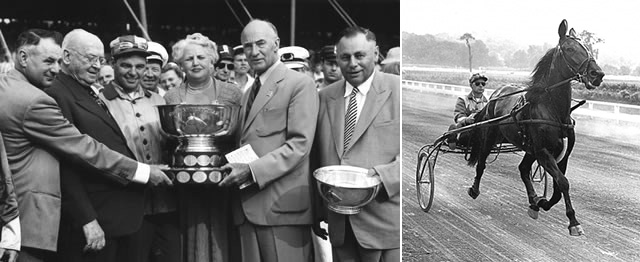
Left: A joyous winner's circle celebration following Helicopter's upset victory in 1953 Hambo at Goshen, New York's Historic Track. From left: C.E. Armstrong, Mr. Wm. Cane, driver Harry Harvey, Mrs. J. Elgin Armstrong, Mr. Roland Harriman, and J. Elgin Armstrong (Hambletonian Society). Right: Helicopter scores on Hambo Day in rein to a young Harry Harvey.
Mr. Harvey recently passed away on July 17th, just three months short of the age of 93, making him even older than the Hambletonian itself. His obituary reads much like a novel, woven with many interesting tales. Born in rural Vermont one of 12 children, his entire life was spent around horses dating all the way back to his early childhood when he drove his siblings to school in a pony cart. His innate ability to assess breeding lines as well as his overall knowledge of the harness racing business as a whole led him through a long and rewarding career. He was also responsible for introducing the great horse Albatross to the world of harness racing. Despite his tremendous talent in a variety of fields he always preferred to shun the spotlight.
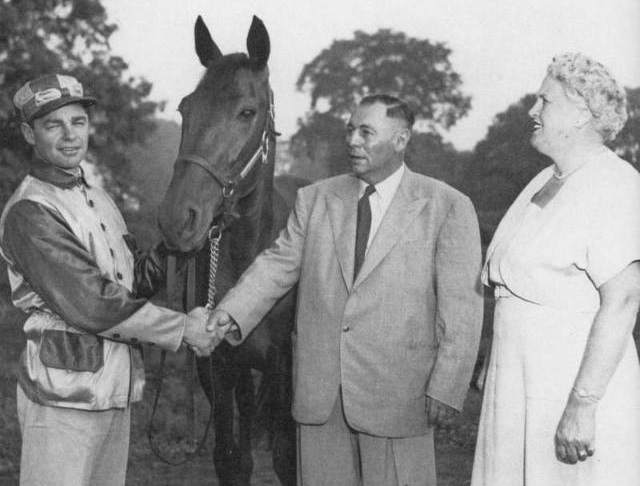
From left: Driver Harry Harvey, Helicopter, Elgin Armstrong & Mrs. Vivian Armstrong enjoy the experience of winning a Hambletonian (Hoof Beats Photo, Courtesy of Don Daniels)
While the subject of youth in drivers may have occupied the day, another driver was also at the forefront and not based on his youth. The legendary TOM BERRY, at the age of 71 was competing in his 21st Hambletonian behind the heavily-regarded Kimberly Kid. In the third heat, he narrowly missed a victory as his horse broke right at the wire. A win here would have caused a fourth heat, which would have carried the program into near darkness as the first heat went postward at 3:00 p.m. The team of Kimberly Kid and Mr. Berry did win the Kentucky Futurity that year in a time just over 2:00.
As the final heat was decided there was a bit of irony at play as the young Harry Harvey bested the veteran Mr. Berry as his mount Kimberly Kid made a costly break just before the wire. A decade earlier, Harvey had been an understudy to the great reinsman, who he admired for as long as he had known him.
A testament to the strength and durability of a harness driver and his staying power was strongly displayed this day by driver Fred Parks. In his three trips to the post behind the filly Anchora Hanover, he ended the day with a standing of 20-20-20. Mr. Parks was the long-time trainer and driver for The Seymour Stable of Dekalb Junction, New York and certainly experienced many better days than this.
One of the entrants in that year's race later became well known to Canadian race fans. Aerial Gunner, who had a less than auspicious showing this day finishing 14-8-15, did go on to a successful career. First racing on the Montreal circuit for Jimmy Larente, Aerial Gunner later made his way to Southwestern Ontario in the ownership of Ellis Dell of Becher, Ont. He sired many useful race horses who campaigned for Ellis and other owners.
Down through the years Canadian-born drivers have fared well in Hambletonian competition, but even in this year's huge field of 23, there were no Canadian pilots.
Many "Firsts" in the 1953 Hambletonian
A tremendous amount of history or "new ground" was broken in this year's Hambletonian. Listed below are some of the milestones recorded in the 1953 Hambo edition.
► First victory by an ownership outside of the U.S.
► First $100,000+ Purse
► First foal by Hoot Mon to be ever sold at auction
► Hoot Mon became first Hambletonian winner to sire a winner
► First stallion to sire a winner in his first crop
► Largest Field - 23
As the shadows of late afternoon began to gather on that mid-August day 63 years ago, the cast assembled was of the most unexpected group imaginable. New owners racing in their first ever Hambletonian, a young filly whose mother was sold by Hanover Shoe Farm for $50 due to a winged foot, and a young driver who despite his lack of experience showed that he was truly equal to the task.
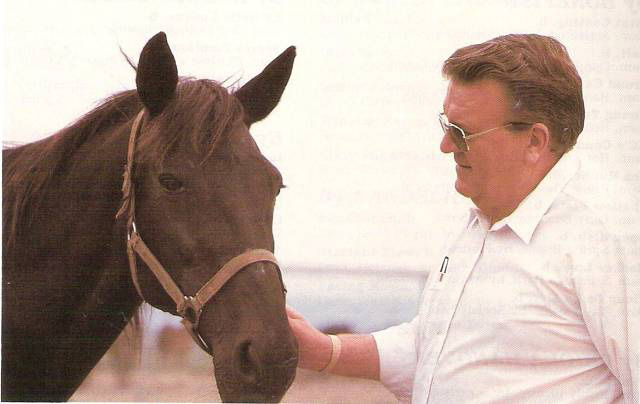
Dr. Glen Brown appears in this 1986 photo with the great mare Armbro Flight, a daughter of Helicopter and a valued part of the great legacy she created. At this time she was 24 years old.
Helicopter went on to be a valued member of the Armstrong broodmare band, eventually producing Armbro Flight and Armbro Jewel. In 1965, another great moment was narrowly missed when Armbro Flight finished second in the Hambo.
Helicopter died at the age of 22 in 1972 at Hanover Shoe Farms while there for breeding. Elgin Armstrong wanted her to be buried at the original Armbro Farm as a tribute to her tremendous contributions. The folks at Hanover arranged to have her embalmed and an Armstrong truck was sent to pick her up. Apparently all went well except that Customs could not find any section in their codes to treat embalmed horses. According to Dr. Brown, after a phone call or two they let her in.
A Great And Memorable Milestone In The History Of Canadian Harness Racing.
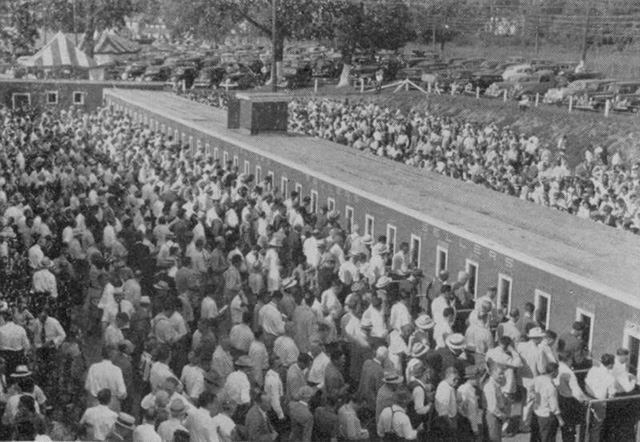
A very old photo taken at Goshen showing the long lines waiting to place their wager.


I moved to Woodbridge in 1963
I moved to Woodbridge in 1963 and every year before the sales Armstrongs had yearling viewing day at the farm in Brampton. As soon as you'd meet Elgin he'd ask if you boys have seen the Helicopter Hambletonian. Of course you'd always say no although you'd have seen it every year. Then he'd invite you into his office/tackroom, hand out a glass of whiskey and a cigar and set up the movie projector and screen and we'd all watch Helicopter win the Hambo again!